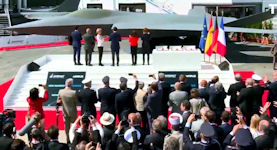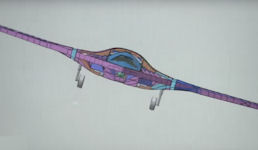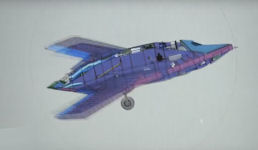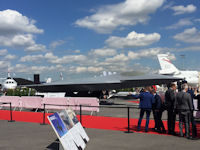Next Generation Fighter (NGF)
Future Combat Air System (FCAS) - France + Germany + Spain -
 In April 2021 Airbus and Dassault Aviation reached a critical deal after weeks of tense discussions over the share of work on the Future Combat Air System. The Franco-German-Spanish fighter deal still faces political uncertainty in a German election year and national differences over technology rights, but is seen as a milestone for Europe's largest defence project.
In April 2021 Airbus and Dassault Aviation reached a critical deal after weeks of tense discussions over the share of work on the Future Combat Air System. The Franco-German-Spanish fighter deal still faces political uncertainty in a German election year and national differences over technology rights, but is seen as a milestone for Europe's largest defence project.
As the "System of Systems", FCAS Future Combat Air System is to connect all components in aerial combat from 2040 - manned and unmanned. The aim is to create a large-scale system that connects the individual systems of the participating countries with the support of artificial intelligence. The heart of every FCAS Future Combat Air System is the NGWS Next generation weapon system that Germany, France and Spain are developing together. It consists of three components: the Next Generation Fighter (NGF), unmanned support aircraft and a Combat Cloud that connects everything together.
After Germany formally joined the project and the joint concept study in October 2019 and the budget committee of the German Bundestag approved the project with a volume of 78 million euros in February 2020, it became a matter of concrete technology and demonstrator development. The focus is not only on the technologies for the future combat aircraft and engine, but also those for the remote carriers. The first mockup of the new fighter plane was unveiled at the Paris Air Show in Le Bourget in June 2019. A first prototype is expected to be tested from 2026.
The Air Chiefs of the German, French and Spanish Air Forces signed two important key documents 26 May 2020 for the further development of the Next Generation Weapon System (NGWS Next generation weapon system) and the national Future Combat Air System (FCAS Future Combat Air System). The German Air Force inspector, Lieutenant General Ingo Gerhartz, the French Air Force inspector General Philippe Lavigne and the Spanish Air Force inspector General Lieutenant Javier Fern�ndez had already agreed on the content of a video conference on 07 May 3030 to accompany the NGWSNext generation weapon system-Program at work and management level since the beginning.
The first is a common vision of the Air Force, the " Common Understanding Connectivity" (CUC), to promote the interoperability of its own air combat components and that of its multinational partners and the path to connectivity of the NGWS Next generation weapon system/ FCAS Future Combat Air Systemto pave. Interoperability is the ability of different systems to work together as seamlessly as possible. Connectivity basically describes the ability of operating systems to establish a connection between a computer and networks. A common understanding of the operation of complex communication systems is a key element of the NGWSNext generation weapon systemProgram. The CUC enables partners to bring their development programs closer together and to coordinate them.
The second topic concerns the evaluation criteria for the architecture of the NGWSNext generation weapon system. So far there were ten different models of how the system could be built. There are several concepts for the planned new fighter aircraft ( Next Generation Fighter) as well as for the unmanned support aircraft (Remote Carrier) with differences in range, maneuverability, armament and others. The Air Chiefs have now jointly weighted the evaluation criteria for the architectures in order to support the joint project team in their selection in a later phase of the concept study.
The agreement to advance construction of a joint advanced combat aircraft program was ceremonially signed by French and German defense ministers in February 2020. This came after the contract for the first phase of the program to build the main aircraft of the Future Combat Air System was awarded. It covers the plane's propulsion system, data architecture and simulation environment, the German Defense Ministry said. Airbus, MTU, Safran and Dassault are the lead contractors.
In front of a full-size, veiled mock-up of the Future Combat Air System Next Generation Fighter (NGF), French, Spanish and German defense ministers signed an accord 17 June 2019 on the development of the sixth-generation aircraft before dramatically unveiling the model. The FCAS is expected to become their mainstay fighter jet by 2040. At the Paris Air Show, the defense ministers of France, Germany and Spain committed themselves to the development of the FCAS in front of a model of the futuristic fighter jet.
"In 2040, the French armed forces would be equipped with a combat aircraft, built between Europeans, to face the fights of tomorrow," French Defense Minister Florence Parly said, adding, "This is historical, and that's just the beginning.� The FCAS would be the latest in a line of aircraft jointly produced by European powers. Other planes developed and used by multiple European nations include the Panavia Tornado, the Eurofighter Typhoon and the SEPECAT Jaguar.
The plane would represent a qualitative leap ahead of present-day top-of-the-line jets like the F-35 Lightning II and J-20, which are referred to as fifth-generation jet aircraft. They have capabilities like look-down shoot-down and stealth technology, and they rely to an unprecedented degree on software to manage flight processes and communication.
While fifth-generation is itself an ill-defined term coined by F-22 and F-35 maker Lockheed Martin partly as a marketing ploy, sixth-generation is even less well-defined. A definition fielded by the US Air Force in 2010 included "enhanced capabilities in areas such as reach, persistence, survivability, net-centricity, situational awareness, human-system integration, and weapons effects,� and noted �it must be able to operate in the anti-access/area-denial environment that would exist in the 2030-2050 timeframe."
On 17 June 2019 Dassault Aviation and Airbus SE delivered a joint industrial proposal to the governments of France and Germany for the first Demonstrator Phase of the Future Combat Air System (FCAS). This next major milestone achievement in the programme was showcased by the reveal of the New Generation Fighter and Remote Carriers models to a world public on the opening day of the 2019 Paris Air Show. The reveal of the models by Eric Trappier, Chairman and Chief Executive Officer (CEO) of Dassault Aviation and Dirk Hoke, CEO of Airbus Defence and Space was witnessed by the host of the opening ceremony at Le Bourget airport, President of the French Republic, Emmanuel Macron, and the French Minister of the Armed Forces, Florence Parly, the German Federal Minister of Defence, Ursula von der Leyen and the Spanish Minister of Defence, Margarita Robles.
This Demonstrator Phase would cover the period between 2019 and mid-2021 and would serve as a starting point for demonstrators and technology development for a New Generation Fighter (NGF), Remote Carriers (RC) and an Air Combat Cloud (ACC) to fly by 2026. The various teaming agreements, which also include the companies MBDA Systems and Thales, contain a defined scope of planning of the first Demonstrator Phase, ways of working and commercial agreements. Additionally, a transparent and fair handling of Intellectual Property Rights has been established in the respective teaming agreements. In parallel, Safran and MTU are in charge of developing a New Engine.
�The Joint Concept Study awarded to Dassault Aviation and Airbus in January 2019 was the first step in a fruitful cooperation between both companies. The first Demonstrator Phase marks another decisive step in the Next Generation Weapon System industrial organisation in which the New Generation Fighter, to be built by Dassault and Airbus, with Dassault Aviation as Prime contractor, as well as the Remote Carriers and Air Combat Cloud with Airbus as Prime contractor, would be the corner stone of the Future Combat Air System�, said Eric Trappier, Chairman and Chief Executive Officer of Dassault Aviation. �The progress we have achieved on the FCAS programme in recent months is remarkable. It would shape Europe�s most decisive military air combat programme for the decades to come and turn out a strong move in constructing Europe�s sovereignty.�
Dirk Hoke, Chief Executive Officer of Airbus Defence and Space, said: �I am very satisfied with the level of trust and partnership we have built with Dassault already in the execution of the Joint Concept Study, and now with the industrial proposal we�ve submitted to the both governments. The principles of our industrial cooperation include joint decision making, a clear governance set-up, transparent ways of working, and a common preparation and negotiation of this first phase of the demonstrator activities.�
After initiating the negotiation phase through the delivered proposal, Dassault Aviation and Airbus expect a contract award for the first Demonstrator Phase by Q4 2019.
On 17 June 2019, at the 2019 Paris Air Show, the Governments of France and Germany officially welcomed Spain as a partner nation in the sixth-generation Future Combat Air System (FCAS) program. With the agreement, announced by French Defence Minister Florence Parly, German Defence Minister Ursula von der Leyen, and Margarita Robles, Defence Minister for Spain, in the presence of French President Emmanuel Macron, three Airbus home nations now form the core part of Europe�s most decisive military aviation programme for the next decades.
Alberto Guti�rrez, Head of Military Aircraft at Airbus Defence and Space, said: �Starting FCAS on a bilateral basis between France and Germany was important to kick-start the programme and to get it on track. The integration of Spain now is a credible step forward towards the envisioned Europeanisation of FCAS. Not only is Spain one of Airbus� founding countries but it�s also an industrial stronghold for military aircraft in our company. The country is a key contributor to Europe�s defence capabilities as well as an experienced and trusted partner in joint defence programmes. So we�re not only glad to see Spain join FCAS, we also believe it is a natural evolution for the programme.�
French Air Force Chief of Staff Gen. Philippe Lavigne told reporters in February 2019 the aircraft would be �optionally manned,� similar to the US� upcoming B-21 Raider project.
The future operating environment would be contested, congested and complex. A future fighter system would need to be capable, flexible, upgradeable, connected and affordable to ensure we deliver a system to meet the demands of the operating environment, both known and unknown.
A future combat air system must be able to survive the most challenging combat environments meaning that payload-range, speed and manoeuvrability would be key. We expect that the system would be equipped with a range of sensors including radio frequency, active and passive electro-optical sensors and advanced electronic support measures to detect and intercept threats. The system is likely to operate with kinetic and non-kinetic weapons. The integration of Laser Directed Energy Weapons for self-defence and use within visual range combat is also highly likely. The ability to deploy and manage air launched �swarming� Unmanned Air Vehicles (UAV) through a flexible payload bay allows the system to address dangerous Anti-Access Area Denial environments.
Air forces of the future would require a fighter system that is highly flexible and can be applied to a wide variety of military operations. Operators would have the ability to rapidly adapt the system to perform new functions or to change its performance. Depending on the mission, �role fit� additions such as low observable conformal fuel tanks, weapons dispensers, air launched UAV dispensers, large modular sensors, long range oblique photography systems for reconnaissance and Laser Directed Energy Weapons could be available.
Adaptability would be built into the system design, with systems architectures which support a �plug and play� approach, easily integrating new algorithms and hardware. The system would also support �scalable autonomy� to provide a number of modes of unmanned operation and a range of pilot decisions aids when manned flight is being conducted. These features are dynamically reconfigurable and serve to enhance survivability, availability, cyber resilience, and tactical options.
To deliver significant information advantage and mission effectiveness, the future combat air system would act as a �force multiplier�, interoperating with a wide range of other civil and military platforms and services across air, land, sea, space and cyber domains � as well as unmanned systems. Command and control of other systems, such as UAVs, would be enabled from a fully customisable virtual cockpit, with advanced human machine interfaces including eye tracking and gesture based controls, offering intuitive and sophisticated mission management. Using a similar virtual approach, both mission planning on the ground, and the remote command of unmanned aircraft can be enhanced, ensuring a rapid and effective understanding of the battlespace.
The FCAS would be quickly and affordably upgradable, maintaining Operational Advantage and Freedom of Action in a rapidly evolving threat environment. Physical interfaces must therefore be strong, lightweight, numerous, and affordably produced. This would be achieved through our expertise in additive layer manufacture, joining and fastener technology, �geometric locking�, and low observable materials. Robotic and cobotic assembly is likely to play a significant role.
Advanced manufacturing techniques would play a significant role in reducing the unit production cost of a FCAS, and would be a key enabler of flexibility and upgradeability. For example, in-service support costs can be reduced by using robotics adapted from manufacturing to re-fuel, re-arm, role-fit, and repair.
Exoskeletons, wearable displays and computing to provide hands-free instructions, guidance and technical publications could further reduce in-service support costs by helping to improve resource flexibility, improve the quality of work, and the speed at which tasks are performed. The use of artificial intelligence and data analytics in vehicle health and mission related data would improve aircraft availability as well as increase the mission success probability. Training costs could be significantly reduced using the virtual cockpit and virtual mission planning system as a result of their low cost, flexibility, and extreme portability.
Germany strains its French friends with its national peculiarities: where the French armaments department DGA has almost complete freedom in the implementation of the project, the principle of distributed competencies applies in Germany: the ministries for economy and defense as well as the chancellery have to deal with the Bundestag and a private industry: it takes time, is difficult and often leads to unsatisfactory compromises. The decisive role of the Bundestag is particularly irritating to Paris. He refuses to simply release development funds for the FCAS for years without proof of success. Because Parliament saw the initial problems coming, the money is only gradually being released, setting guidelines and asking questions. This approach is completely alien to France.
In France, the arms industry is a key tool here to preserve national sovereignty, and therefore worth protecting and even national pride. In addition, the state is still significantly involved in this economically important industry. Germany's defense industry, on the other hand, is private, economically insignificant and political circles tend to avoid the arms industry.
|
NEWSLETTER
|
| Join the GlobalSecurity.org mailing list |
|
|
|








